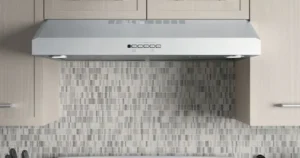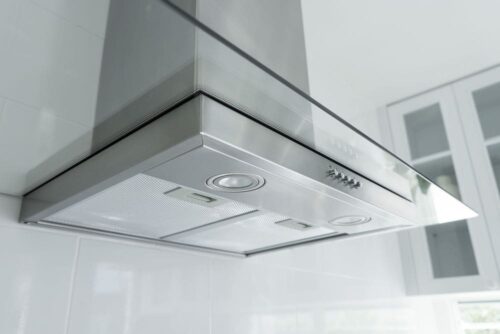Keeping your kitchen air fresh and free from smoke, grease, and odors is essential, and range hoods are a key solution. With more homeowners looking for flexible options, ductless range hoods have become increasingly popular, but many still wonder, do ductless range hoods work.
Also, many still question if they can truly handle the demands of regular cooking while providing effective ventilation. Understanding their role and capabilities can help you make a smarter choice for your kitchen.
People wonder if these systems can truly handle the challenges of everyday cooking or if they are just a space-saving alternative with limited performance. Understanding this can help anyone make a more informed decision when choosing the right kitchen ventilation.
How Ductless Range Hoods Operate

Ductless range hoods are a popular kitchen appliance for homes without external venting. Unlike traditional hoods, they don’t expel air outside but instead filter and recirculate it. Understanding how they operate can help you choose, use, and maintain them effectively.
Operation Steps:
- Air Intake:
The hood draws in cooking fumes, smoke, steam, and odors from the stovetop through a fan. The fan’s speed can often be adjusted to match the cooking intensity. - Filtration:
- Grease Filter: Captures grease and oil particles to prevent them from settling on kitchen surfaces. Most are metal and washable.
- Charcoal Filter: Neutralizes odors using activated carbon. This filter cannot usually be washed and must be replaced periodically.
- Air Recirculation:
After passing through the filters, the cleaned air is released back into the kitchen. Because there’s no duct leading outside, all harmful or odorous particles must be captured within the filters. - Fan & Motor Operation:
The fan’s motor powers the airflow, with multiple speed settings available. Higher speeds handle heavy cooking smoke, while lower speeds are sufficient for light cooking. - Lighting (Optional):
Many ductless hoods have built-in lights to illuminate the cooking area, providing convenience and safety while cooking.
Ductless range hoods operate by pulling in air, filtering grease and odors, and recirculating clean air back into the kitchen. While they don’t require external venting, proper filter maintenance is essential for efficient operation. With regular upkeep, these hoods can keep your kitchen fresh and smoke-free.
Effectiveness of Ductless Range Hoods
Ductless range hoods are a practical solution for kitchens that cannot accommodate traditional vented systems. They are designed to remove smoke, grease, steam, and cooking odors through filtration rather than expelling air outside. But how effective they are depends on several factors including design, airflow, and filter maintenance.
Detailed Factors Affecting Effectiveness:
- Filtration Efficiency:
- Grease Filters: High-quality metal or mesh filters capture grease and oil particles from cooking vapors. If clogged or poorly designed, grease can bypass the filter and settle on cabinets or walls.
- Charcoal/Carbon Filters: These are critical for odor removal. Activated carbon absorbs smoke, cooking smells, and volatile compounds. Their effectiveness diminishes over time, so timely replacement is necessary.
- Airflow and Fan Power:
The effectiveness largely depends on the fan’s airflow capacity, measured in cubic feet per minute (CFM). A higher CFM ensures faster removal of smoke and odors. Smaller hoods with low CFM may struggle during heavy cooking or when frying. - Cooking Type:
Ductless hoods work best for moderate cooking like boiling, steaming, or sautéing. They are less effective for grilling, frying, or high-smoke cooking because odor molecules and grease particles can overwhelm the filters. - Recirculation Design:
Unlike vented hoods, ductless models recirculate cleaned air back into the kitchen. This means effectiveness is limited to how well the filters capture impurities. Without proper filtration, odors may linger longer compared to ducted systems. - Maintenance:
Regular cleaning of grease filters and timely replacement of charcoal filters is essential. Neglecting this reduces airflow, increases smoke buildup, and decreases odor absorption, making the hood much less effective. - Placement and Coverage:
A hood must cover the entire cooking surface. If it’s too small or mounted too high, smoke and odors may escape before being filtered, reducing its efficiency.
Ductless range hoods can be highly effective in controlling smoke, grease, and odors for everyday cooking, especially in kitchens without venting options. Their performance depends on filter quality, fan power, maintenance, and proper installation. While they may not match the efficiency of ducted systems for heavy cooking, regular upkeep ensures a cleaner and fresher kitchen environment.
Advantages of Ductless Range Hoods
Ductless range hoods are a popular choice for kitchens where venting to the outside isn’t possible. They offer unique benefits that make them convenient, versatile, and low-maintenance for many homeowners.
Key Advantages:
- Easy Installation:
Ductless hoods don’t require ductwork or external venting, making them ideal for apartments, condos, or kitchens with limited renovation options. They can often be mounted directly above the cooking area with minimal effort. - Portability and Flexibility:
Since no ducting is required, ductless hoods can be moved or replaced easily. This flexibility allows homeowners to adapt their kitchen layout without major construction. - Energy Efficiency:
By recirculating filtered air back into the kitchen, ductless hoods reduce energy loss compared to venting warm indoor air outside. This can help maintain indoor temperature and lower heating or cooling costs. - Odor and Smoke Control:
Equipped with grease and activated carbon filters, ductless hoods effectively trap cooking odors, smoke, and airborne grease, helping keep your kitchen cleaner and fresher. - Low Maintenance:
With removable and washable grease filters and replaceable charcoal filters, these hoods are easier to maintain than ducted systems that require cleaning of long, inaccessible ducts. - Cost-Effective:
Ductless range hoods are generally less expensive to purchase and install than vented hoods because they eliminate the need for ductwork and complex installation. - Lighting Feature:
Many models come with built-in lights to illuminate the cooking area, enhancing visibility and safety while cooking.
Ductless range hoods offer ease of installation, flexibility, and efficient odor and smoke control without the need for venting. With proper maintenance, they provide a cost-effective, energy-saving, and practical solution for keeping kitchens clean and fresh.
Limitations of Ductless Range Hoods

While ductless range hoods are convenient for kitchens without external venting, they come with certain limitations that can affect their performance. Understanding these drawbacks helps homeowners set realistic expectations and maintain their hoods effectively.
Key Limitations:
- Limited Odor Removal:
Ductless hoods rely on activated carbon filters to neutralize cooking odors. While effective for moderate smells, they are less efficient at eliminating strong or persistent odors compared to ducted systems. - Less Efficient Smoke Extraction:
Because the air is recirculated rather than vented outside, ductless hoods may struggle with heavy smoke, steam, or grease from high-heat cooking such as frying or grilling. - Frequent Filter Maintenance:
Filters need regular cleaning and replacement to maintain efficiency. Grease buildup or saturated charcoal filters reduce airflow and filtration, making the hood less effective over time. - Reduced Airflow Capacity:
Ductless models often have lower fan power (CFM) compared to vented hoods, which can limit their ability to quickly remove cooking fumes in larger kitchens or during intense cooking sessions. - No Heat Removal:
Since ductless hoods recirculate air, they do not remove excess heat from the kitchen. This can make the cooking area warmer, especially during long cooking sessions. - Coverage Limitations:
If the hood is too small or improperly positioned, smoke and odors may escape before reaching the filters, reducing overall effectiveness.
Ductless range hoods are convenient and practical, but they have limitations in odor removal, smoke extraction, and airflow compared to vented systems. Regular filter maintenance and proper placement are essential to maximize their efficiency in keeping the kitchen clean and fresh.
Maintenance Tips for Optimal Performance
Ductless range hoods rely on filters and fans to keep your kitchen clean and odor-free. Proper maintenance ensures they operate efficiently, last longer, and provide consistent air quality.
Maintenance Tips:
- Regular Grease Filter Cleaning:
- Remove metal or mesh grease filters every 1–2 months.
- Soak them in warm, soapy water and scrub gently to remove built-up grease.
- Some filters are dishwasher-safe; check the manufacturer’s instructions.
- Timely Charcoal Filter Replacement:
- Activated carbon filters absorb odors and cannot be washed.
- Replace them every 3–6 months or as recommended by the manufacturer.
- If you cook frequently or fry foods often, replace more frequently for optimal odor control.
- Clean the Hood Exterior:
- Wipe down the hood’s surface weekly using a damp cloth and mild detergent.
- Avoid abrasive cleaners that can damage finishes.
- Check and Maintain the Fan:
- Ensure the fan blades are free from grease buildup.
- Periodically run the hood at maximum speed to ensure smooth operation.
- Monitor Airflow and Odor Performance:
- If smoke or odors linger, it may indicate clogged filters or fan issues.
- Address any airflow reduction promptly to maintain efficiency.
- Avoid Overloading the Filters:
- Heavy cooking that produces excessive smoke or grease may overload filters.
- Run the hood on higher speed settings during such cooking sessions.
- Keep Surrounding Area Clean:
- Regularly clean the stovetop and surrounding surfaces to prevent excess grease from reaching the hood.
Consistent maintenance, including cleaning grease filters, replacing carbon filters, and keeping the hood and surrounding area clean, ensures your ductless range hood performs optimally. Proper upkeep enhances air quality, prolongs lifespan, and keeps your kitchen fresh and odor-free.
Situations Where Ductless Range Hoods Are Best

Ductless range hoods offer convenience and flexibility, but they are not ideal for every kitchen. Knowing the situations where they perform best helps homeowners make informed choices and maximize their effectiveness.
Ideal Situations:
- Apartments and Condos:
In homes where venting to the outside is impossible due to building restrictions, ductless hoods provide an effective solution for controlling smoke and odors without requiring complex installation. - Kitchens Without Existing Ductwork:
If your kitchen lacks ducting and adding it would be costly or impractical, ductless hoods offer an easy, cost-effective alternative that doesn’t require major renovation. - Moderate Cooking Needs:
For households that mostly boil, steam, or lightly sauté foods, ductless hoods efficiently remove smoke, steam, and odors without the need for vented airflow. - Temporary or Portable Kitchens:
Ductless hoods are ideal for temporary kitchens, rental properties, or mobile homes where permanent ductwork is not feasible. - Energy-Sensitive Homes:
Since ductless hoods recirculate air rather than expelling heated or cooled air outside, they help maintain indoor temperature and can be more energy-efficient in climate-controlled spaces. - Limited Installation Space:
When kitchen layout restricts wall or ceiling space for venting, ductless hoods can fit above the cooking surface without structural modifications.
Ductless range hoods are best suited for apartments, kitchens without ductwork, moderate cooking environments, and spaces where installation flexibility or energy efficiency is a priority. Choosing them in the right situation ensures effective smoke and odor control while avoiding unnecessary complications.
Conclusion
Understanding kitchen ventilation is key to keeping your cooking space clean and comfortable. Many people often ask, do ductless range hoods work, as they consider different options for their homes. Ultimately, the effectiveness of any system depends on your cooking habits, kitchen size, and specific needs, making it important to weigh the benefits and limitations before making a choice.

